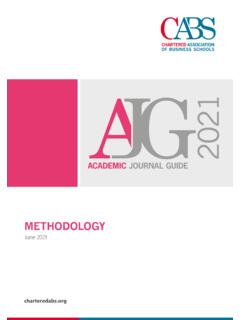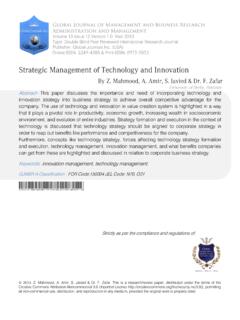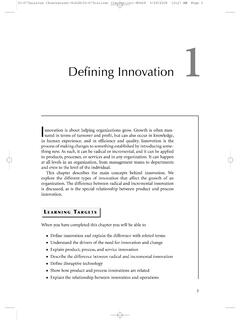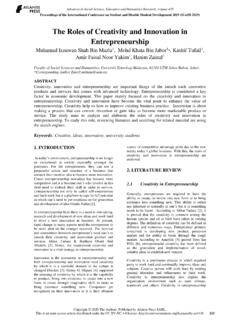Transcription of MODULE 1: THE CONCEPTS OF CREATIVITY AND INNOVATION
1 MODULE 1: THE CONCEPTS OF CREATIVITY AND INNOVATION Project Title Towards a More Innovative Workplace Project Acronym InnoWork Project Reference No: No: 2014-1-BG01-KA202-001634 This project has been funded with support from the European Commission. This publication reflects the views only of the author, and the Commission cannot be held responsible for any use which may be made of the information contained therein. 2 Table of contents I. MODULE overview .. 3 II. Learning content .. 4 Introduction .. 4 Why is CREATIVITY important? .. 4 What are the main characteristics of a creative person? .. 6 How can we develop CREATIVITY ? .. 7 III. Conclusion.
2 11 IV. Additional reading .. 11 V. Self-test questions .. 12 VI. 13 VII. Bibliography .. 15 3 I. MODULE overview Learning objectives As a result of engaging with the materials in this MODULE , learners are intended to achieve the following learning outcomes: Knowledge: gain knowledge on why CREATIVITY is important, what are the main characteristics of CREATIVITY and creative people, how can CREATIVITY be developed. Skills: improved ability to identify CREATIVITY impetuses and obstacles in the organization; improved ability to adapt traditional methods, CONCEPTS , models to new applications; proactive thinking; self-assessment; understanding attitude.
3 Competences: Encouraging CREATIVITY ; facilitating a climate that supports CREATIVITY in an organization; managing change; leader behaviors; analytical thinking. Time schedule Time necessary for: Learning content (self-study): hours Self-test questions: 5 minutes On-line exercises: 20 minutes Structure The MODULE is divided into three main topics: Why is CREATIVITY important? What are the main characteristics of CREATIVITY ? How can we develop CREATIVITY ? The CREATIVITY process is further analyzed through the prism of 3 interesting models. 4 II. Learning content Introduction What is CREATIVITY and what is INNOVATION ? You may have your own definitions and you will be able to see some official definitions in the first sub-chapter of this MODULE .
4 We will also take a look at the main characteristics of a creative person. Did you know creative people have a particular sensitivity to problems? How about you? Are you an adaptor or an innovator? Do you work within the system to improve things or do you challenge the system and come up with proposals for change? In this MODULE we will also discuss how to develop CREATIVITY . You will read about how important it is to allow people to do something they love, free and self-determined, along with some leadership behaviours that should be encouraged in order to achieve this. Three exemplary models on the CREATIVITY process will be explained.
5 The first model contains 8 activities to encourage people to be more creative, the second model is focused on the factors that facilitate and motivate creative behaviours and the third model looks at CREATIVITY from the different viewpoints of the individual, the group and organizational levels. Why is CREATIVITY important? Nowadays, we are entering a new age where CREATIVITY is becoming increasingly important and more and more people are recognizing this. It is now essential to foster and encourage right-directed (as CREATIVITY and emotion) over left-directed thinking (as logical, analytical thought). CREATIVITY is very important in businesses: organizations need it to adapt to the fast-changing environment, to develop new products and to improve customer services.
6 CREATIVITY is also a key to the ongoing vitality and survival of organizations1. In response to this need, managers have invested in various targeted approaches, such as, CREATIVITY training programmes, team-building, and leadership development to improve it. CREATIVITY has been studied from a variety of perspectives. It may be defined as the formation of novel, appropriate and useful ideas by individuals or small In the context of an organization the term INNOVATION is often used to refer to the entire process by which an organization achieves creative problem solving, generates creative new ideas and converts them into novel, useful and viable commercial products, services and business practices.
7 Last but not least, the European Parliament emphasizes the importance of CREATIVITY asserting to promote CREATIVITY , through lifelong learning, as a driver for INNOVATION and as a key factor for the development of 1 Gruys, Melissa L., Munshi, Natasha V., Dewett, Todd, C., When Antecedents Deverge: Exploring Novelty and Value as Dimensions of CREATIVITY , ELSEVIER, Thinking Skills and CREATIVITY 6, p. 132-137, 2011. 2 Idem. 5 personal occupational, entrepreneurial and social competences and the well-being of all individuals in society 3. The European Union declared 2009 as The European Year of CREATIVITY and INNOVATION where it was said that More than ever, Europe s future depends on the imagination and CREATIVITY of its people 4.
8 As R. K. Sawyer states: CREATIVITY will continue to increase in importance, due to several broad societal and economic trends: 1. Increasingly, globalized markets result in greater competitiveness, even for industries that historically had been protected from significant challenge. 2. More and more sophisticated ICT result in shorter product development cycles. 3. Jobs that don t require CREATIVITY are increasingly being automated, or are moving to extremely low-wage countries. 4. Growing wealth and leisure time in advanced countries (and beyond) have raised the demand for the products of the creative industries. As of 2007, the creative industries represented over 11% of GDP 5.
9 As Gerhard Fischer argues, we have to underline the social nature of creativity6. CREATIVITY does not happen inside people s minds, but in the interaction between a person s thought and a socio-cultural context. To sum up, CREATIVITY contributes in several areas, such as INNOVATION , problem solving, planning and decision-making7. Moreover, CREATIVITY has been described as the most important economic resource of the 21st century8. 3 European Parliament and Council Decision, 1350, 1-9, 2008. 4 European Ambassadors for CREATIVITY and INNOVATION , Manifesto, Imagine, Create, Innovate, An Initiative of the European Union, 2009.
10 5 Sawyer, R. Keith, Explaining CREATIVITY : The Science of Human INNOVATION , 2nd edition, Oxford University Press Inc., 2012. 6 Fischer, Gerhard, Learning, Social CREATIVITY , and Cultures of Participation, in: A. Sannino, & V. Ellis (Eds.), Learning and Collective CREATIVITY : Activity-Theoretical and Sociocultural Studies, Taylor & Francis/Routledge, New York, NY, p. 198-215, 2014. 7 Andiliou, Andria, Murphy, P. Karen, Examining Variations among Researchers and Teachers Conceptualizations of CREATIVITY : A Review and Synthesis of Contemporary Research, ELSEVIER, Educational Research Review 5, p. 201-219, 2010. 6 Questions for reflection Where and why is CREATIVITY important in your business ?







